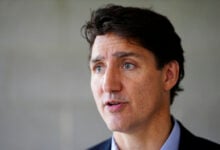Israel bombs Beirut, killing 18 near hospital
18 killed in Beirut hospital bombing, conflict with Hezbollah intensifies

Israel continued bombing Lebanon on Tuesday, with a late-night strike killing 18 people near a Beirut hospital. State media reported that the conflict with Hezbollah is nearing its one-month mark. Since September 23, the death toll in Lebanon has reached at least 1,552, according to health ministry figures, though actual numbers could be higher due to incomplete data.
Four strikes hit Beirut’s southern suburbs, a Hezbollah stronghold. AFP footage showed smoke rising in the area. The strikes interrupted Hezbollah’s press conference after the Israeli army issued an evacuation order. An Israeli strike hit near the venue just after reporters left. In the Ghobeiri area, an 11-storey apartment complex was levelled.
In southern Lebanon, three paramedics were injured in Nabatiyeh during a rescue mission coordinated with UN peacekeepers. The strikes created a “belt of fire,” destroying residential buildings, shops, and cafes in “less than 30 seconds.” NNA described one street as resembling a “terrifying battlefield.”
Israeli airstrike near Lebanon’s largest hospital kills at least 18 people pic.twitter.com/i4biM3G0io
— Channel 4 News (@Channel4News) October 22, 2024
The Israeli army also bombed Al-Hawsh, south of Tyre. AFPTV footage showed smoke over the area. Tuesday’s bombardment followed heavy shelling the previous day, which resulted in 63 deaths and 234 injuries. On Monday, 18 people, including four children, were killed near a south Beirut hospital. The strike near Rafic Hariri Hospital, Lebanon’s largest public health facility, wounded 60 others and caused minor damage to the hospital itself.
The densely populated neighbourhood saw no evacuation warning before the strike. Four nearby buildings were flattened, and rescuers continued searching for survivors on Tuesday. Resident Ola Eid recounted watching her neighbourhood bombed from her balcony. She described children playing and receiving treats before being struck by the bombs.
Israel accused Hezbollah of storing money in a bunker under the nearby Sahel Hospital, a claim denied by the facility’s owner. Journalists toured the hospital on Tuesday as calls for protecting Lebanon’s medical infrastructure grew. Both Sahel and Rafic Hariri Hospitals have treated casualties from Israeli strikes.
The Lebanese Ministry of Health is claiming that 18 were Killed and over 100 Injured in tonight’s Series of Israeli Airstrikes on the Capital of Beirut, with several High-Rise Apartment Buildings said to have Collapsed or Partially-Collapsed. pic.twitter.com/EWJQJoKyH9
— OSINTdefender (@sentdefender) October 10, 2024
Last month, Israel expanded its war from Gaza to Lebanon, aiming to secure its northern border and allow displaced people to return. Hezbollah confirmed that some fighters were taken prisoner but did not provide numbers. The Israeli army previously stated it captured four Hezbollah fighters and released footage of one being questioned. Hezbollah also claimed responsibility for a drone strike targeting Israeli Prime Minister Benjamin Netanyahu’s residence in Caesarea at the weekend.
What Other Media Are Saying
- BBC reports on a rare Israeli strike in northern Lebanon, highlighting civilian casualties in a predominantly Christian village, amid escalating tensions in the region.(read more)
Frequently Asked Questions
Here are some common questions asked about this news
How many people have died in Lebanon since the conflict began?
At least 1,552 people have died since September 23, according to health ministry figures.
What was targeted in the Israeli strikes on Beirut’s southern suburbs?
Israeli strikes hit Hezbollah strongholds and leveled an 11-storey apartment complex in Ghobeiri.
Were there any warnings before the strikes near Rafic Hariri Hospital?
No evacuation warning was given before the strikes in the densely populated neighborhood.
What did Israel accuse Hezbollah of storing under Sahel Hospital?
Israel accused Hezbollah of storing money in a bunker under Sahel Hospital, a claim denied by the hospital’s owner.
What recent action did Hezbollah claim responsibility for?
Hezbollah claimed responsibility for a drone strike targeting Israeli Prime Minister Benjamin Netanyahu’s residence in Caesarea.







